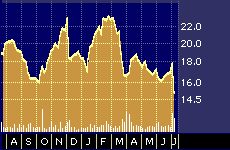
Pick of the Week: Coca-Cola
Pick of the Week: Coca-Cola
By Hal Plotkin
CNBC.com Silicon Valley Correspondent
Mar 26, 2001 07:30 AM
| Who | Timothy Ghriskey, portfolio manager of the $105 million Dreyfus Aggressive Value {DAGVX}fund. |
| Stock Pick | Coca-Cola Enterprises Inc. {CCE} |
| Recent Price | $20.36 |
| Appreciation Potential | $30 within 18 months. |
| Reason to Buy | Coke’s additional $300 to $500 million marketing push expected to boost stock of leading Coke bottler. |

It’s not often that a stock gets a lift because another company increases its marketing budget. That’s what should happen to Coca-Cola Enterprises Inc.’s stock over the next 12 to 18 months, says Timothy Ghriskey, portfolio manager of the $105 million Dreyfus Aggressive Value {DAGVX} fund.
Ghriskey says Coca-Cola Enterprises Inc.’s stock should appreciate 50 percent or more as the company benefits from a re-invigorated marketing effort by the owner of its main product, Coke.
Coca-Cola Enterprises is the world’s largest bottler of liquid nonalcoholic drinks. The company operates in 46 of the 50 U.S. states, all 10 provinces in Canada, and parts of Europe, including Belgium, France, Great Britain, Luxembourg, Monaco, and the Netherlands. The stock trades separately from the stock of The Coca-Cola Company {KO}, which owns the lucrative Coke trademark in addition to a variety of other business divisions.
“Coca-Cola Enterprises has got a big new push coming from Coca-Cola on the marketing side, and all of that new spending by Coke benefits Coca-Cola Enterprises without them having to pay anything,” says Ghriskey.
In February, the Coca-Cola Company announced plans to implement a one-time only $300 to $500 million-dollar increase in its marketing budget for the balance of the current calendar year, although the company did not reveal the precise amount that will be spent on marketing in 2001.
In making the announcement, Coca-Cola Company president Jack Stahl said increased spending on marketing is the single best investment his company can now make.
“We are confident that these one-time investments will have significantly greater long-term returns than many of the recent acquisition opportunities that we have evaluated,” Stahl said when he announced the fortified marketing plan.
“What I’m counting on is that the new marketing push will not be the same old thing,” says Ghriskey. “The company has clearly made some mistakes recently with its ads, but I think they now understand what they need to do to attract the primary consumption demographics they’re after.”
Ghriskey ticks off a few other factors that he says should work to the benefit of Coca-Cola Enterprises’ shareholders in the months ahead.
He says raw material costs in the bottling industry are under control and pose no threat to profitability, and that Coca-Cola Enterprises faces negligible capital spending needs over the foreseeable future.
“We’re also seeing a return in Coke volumes to more normalized levels,” he says.
In February, the Coca-Cola Company reaffirmed its guidance for the coming year, which calls for a 6 to 7 percent increase in case volumes as compared with the previous year.
“They can’t do that without the bottles,” says Ghriskey, who adds that Coca-Cola Enterprises’s stock also looks like a safe, or at least safer, haven in a market where investors are increasingly running for cover.
On January 23, Coca-Cola Enterprises posted earnings of 50 cents per share for fiscal 2000, a number that analysts now expect will grow to 59 cents a share in 2001, according to First Call Corp.
“The year 2000 was a challenging period…with slower than expected volume growth in North America and difficult market conditions in Great Britain,” said Summerfield Johnston, Jr., Coca-Cola Enterprises chairman and chief executive officer, when the company’s year-end figures were announced.
But Johnston supports Ghriskey’s assertion that 2001 should be a better year.
“In North America, we’ve begun to see a return to volume growth on a foundation of improved pricing and profitability,” Johnston said, while “in Great Britain, strong fourth quarter volume growth demonstrates the strength of our brands…and the significant opportunities we have to build per capita consumption. Our other European territories – particularly France – continue to perform very well, achieving both volume growth and improved pricing.”
“The [bottling sector] is a defensive sector,” Ghriskey says. “People tend not to cut back soft drink consumption in a weak economy, so when the numbers start coming in I think the stock will look a lot better to investors over the next year.”


